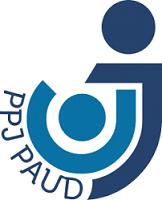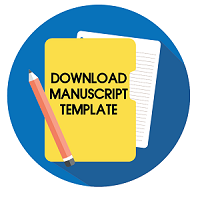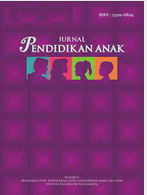Pengaruh Family Literacy Programs terhadap Perkembangan Keaksaraan Awal Anak Usia Dini
Siti Wahyuningsih, Universitas Sebelas Maret, Indonesia
Muhammad Munif Syamsuddin, Universitas Sebelas Maret, Indonesia
Abstract
Keywords
Full Text:
PDFReferences
Association of School Librarians and Association of Educational Communications Technology. (1997). Infromation literacy standards for student learning. TechTrends, 42(1), 52–53. https://doi.org/10.1007/bf02818967
Boudreau, D. (2005). Use of a parent questionnaire in emergent and early literacy assessment of preschool children. Language, Speech, and Hearing Services in Schools, 36(1), 33–47. https://doi.org/10.1044/0161-1461(2005/004)
Christianti, M. (2015). Membaca dan menulis permulaan untuk anak usia dini. In Jurnal Pendidikan Anak (Vol. 2, Issue 2). https://doi.org/10.21831/jpa.v2i2.3042
Crosby, S. A., Rasinski, T., Padak, N., & Yildirim, K. (2014). A 3-year study of a school-based parental involvement program in early literacy. The Journal of Educational Research, 108(2), 165–172. https://doi.org/10.1080/00220671.2013.867472
Drouin, M., & Harmon, J. (2009). Name writing and letter knowledge in preschoolers: Incongruities in skills and the usefulness of name writing as a developmental indicator. Early Childhood Research Quarterly, 24(3), 263–270. https://doi.org/10.1016/j.ecresq.2009.05.001
Ebert, S., Lockl, K., Weinert, S., Anders, Y., Kluczniok, K., & Rossbach, H. (2013). Internal and external influences on vocabulary development in preschool children. School Effectiveness and School Improvement, 24(2), 138–154. https://doi.org/10.1080/09243453.2012.749791
Fitzgerald, J., & Shanahan, T. (2000). Reading and writing relations and their development. Educational Psychologist, 35(1), 39–50. https://doi.org/10.1207/S15326985EP3501_5
Higgins, K. E., Arditi, A., & Knoblauch, K. (1996). Detection and identification of mirror-image letter pairs in central and peripheral vision. Vision Research, 36(2), 331–337. https://doi.org/10.1016/0042-6989(95)00117-i
Ihmeideh, F., & Al-Maadadi, F. (2020). The effect of family literacy programs on the development of children’s early literacy in kindergarten settings. Children and Youth Services Review, 118, 1–7. https://doi.org/10.1016/j.childyouth.2020.105462
Jordan, G. E., Snow, C. E., & Porche, M. V. (2000). Project EASE: The effect of a family literacy project on kindergarten students’ early literacy skills. Reading Research Quarterly, 35(4), 524–546. https://doi.org/10.1598/RRQ.35.4.5
Lonigan, C. J., Burgess, S. R., & Anthony, J. L. (2000). Development of emergent literacy and early reading skills in preschool children: Evidence from a latent-variable longitudinal study. Developmental Psychology, 36(5), 596–613. https://doi.apa.org/doi/10.1037/0012-1649.36.5.596
Lonigan, C., Schatschneider, C., & Westberg, L. (2008). Identification of children’s skills and abilities linked to later outcomes in reading, writing, and spelling. Developing Early Literacy: Report of the National Early Literacy Panel: A Scientific Synthesis of Early Literacy Development and Implications for Intervention, 55–106.
Neumann, M. M., Finger, G., & Neumann, D. L. (2017). A conceptual framework for emergent digital literacy. Early Childhood Education Journal, 45(4), 471–479. https://doi.org/10.1007/s10643-016-0792-z
Puglisi, M. L., Hulme, C., Hamilton, L. G., & Snowling, M. J. (2017). The home literacy environment is a correlate, but erhaps not a cause, of variations in children’s language and literacy development. Scientific Studies of Reading, 21(6), 498–514. https://doi.org/10.1080/10888438.2017.1346660
Putri, M. A. (2021). Penerapan pembelajaran literasi di tk rumahku tumbuh. Jurnal Pendidikan Anak, 10(1), 77–87. https://journal.uny.ac.id/index.php/jpa/article/view/38748
Roberts, J., Jurgens, J., Burchinal, M., & Graham, F. P. (2005). The role of home literacy practices in preschool children’s language and emergent literacy skills. Journal of Speech, Language, and Hearing Research, 48, 345–359. https://doi.org/10.1044/1092-4388(2005/024)
Rose, E., Lehrl, S., Ebert, S., & Weinert, S. (2018). Long-term relations between children’s language, the home literacy nvironment, and socioemotional development from ages 3 to 8. Early Education and Development, 29(3), 342–356. https://doi.org/10.1080/10409289.2017.1409096
Saint-Laurent, L., & Giasson, J. (2005). Effects of a family literacy program adapting parental intervention to first graders’ evolution of reading and writing abilities. Journal of Early Childhood Literacy, 5(3), 253–278. https://doi.org/10.1177%2F1468798405058688
Sowers, J. (2000). Language arts in early education. Stamford, CT: Delmar Thomson.
Storch, S. A., & Whitehurst, G. J. (2001). The role of family and home in the literacy development of children from low-income backgrounds. New Directions for Child and Adolescent Development, (92), 53–71. https://doi.org/10.1002/cd.15
Sugiyono. (2019). Metode penelitian kuantitatif, kualitatif, dan R&D. Bandung: Alfabeta.
Swain, J., & Cara, O. (2018). Developing closer parent – school relations the role of family literacy classes in demystifying school literacies and developing closer parent – school relations. Cambridge Journal of Education, 1–21. https://doi.org/10.1080/0305764X.2018.1461809
Yunita, N., Kurnia, R., & Chairilsyah, D. (2020). Pengaruh media typewriter alphabet terhadap kemampuan membaca permulaan pada anak usia dini. Aulad: Journal on Early Childhood, 3(1), 45–52. https://doi.org/10.31004/aulad.v3i1.51
DOI: https://doi.org/10.21831/jpa.v11i1.47918
Refbacks
- There are currently no refbacks.
Copyright (c) 2022 Jurnal Pendidikan Anak

This work is licensed under a Creative Commons Attribution-ShareAlike 4.0 International License.
Our Journal indexed by:
Supervised by:
Jurnal Pendidikan Anak is licensed under a Creative Commons Attribution-ShareAlike 4.0 International License.
Based on a work at https://journal.uny.ac.id/index.php/jpa.
Jurnal Pendidikan Anak Stats














